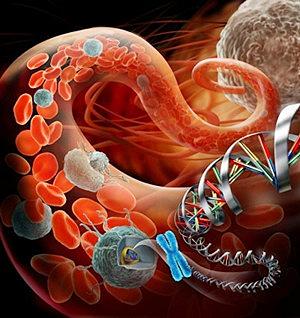New progress on single-cell sequencing has been made by Professor Sunney Xie and Fan Bai¡'s research team at the Biodynamic Optical Imaging Center (BIOPIC), School of Life Science, Peking University, and Jie Wang, Beijing Cancer Hospital. The paper, titled ¡°Reproducible copy number variation patterns among single circulating tumor cells of lung cancer patients¡±, was published on the PNAS¡¯s website on December 10th, 2013. The researchers are the first to provide genome and exome sequencing of circulating tumor cells (CTCs) of cancer patients, which is groundbreaking for the uncovering the molecular mechanism of metastases, and offers a novel technical method to noninvasive CTC-based cancer diagnostics.
Discovered as early as 1896, CTCs, with a high potential to seed metastases, can survive in the circulatory system. As a key step of metastases, a few tumor cells fall off from primary tumor, move into blood or lymph circulatory system, then turn into CTCs, and finally develop into the metastases which cause the majority of cancer-related mortalities. Consequently, the detection of CTCs in peripheral blood suggests the possibility of metastases.

Although CTC counting has been used to predict progression and overall survival of cancer patients, genomic analyses of CTCs will provide a better understanding of the biological mechanism of metastases and more pertinent information for personalized treatment as noninvasive prognosis and diagnosis. However, it is difficult to probe the genomic changes in DNA obtainable from captured CTCs due to low single-cell genome coverage of scarce CTCs.
To meet with this challenge, a single-cell whole-genome amplification method, multiple annealing and looping-based amplification cycles (MALBAC) was developed by Prof. Sunney Xie¡¯s team at Harvard University. The method improves the amplification uniformity across the entire genome over previous methods, allowing precise determination of copy number variations (CNVs) and detection of single-nucleotide variations (SNVs) in a single cell. Taking advantage of MALBAC, the team studied the molecular character of CTCs from lung cancer patients, including adenocarcinoma (ADC) and small cell lung cancer (SCLC), and successfully observed some important SNVs and insertions/deletions in exomes of several important tumor-related genes.
Coincidentally, it was identified that individual CTCs in each patient, regardless of the cancer subtypes, exhibited reproducible CNV patterns, similar to those of the metastatic tumor of the same patient. In addition, different patients with the same ADC shared similar CNV patterns in their CTCs. This finding would change the traditional understanding of tumor heterogeneity, which has been an important feature of cancer for a long time, and reveals that specific copy number changes are crucial to metastases.
Even more interestingly, patients of SCLC have CNV patterns distinctly different from those of ADC patients, indicating some specificity exists among different cancers. This kind of specificity might correlate to the development of cancer and the microenvironment where metastases seed, which would provide a theoretical basis for the classification of different cancer patients in the future.
Xie Xiaoliang, Director of BIOPIC, Fan Bai, associate fellow of BIOPIC and Professor Jie Wang from Beijing Cancer Hospital, are the corresponding authors of this paper. Doctor Li Xiaohui, graduate students Su Zhe and Gao Yan, Zhuo Minglei, Duan Jianchun and Wang Zhijie from Beijing Cancer Hospital , and Doctor Zhong Chenghang from American Baylor College of Medicine, are joint first authors. This research was supported by Peking University Program 985 Special Funding for Collaborative Research with PKU Hospitals, the National Natural Science Fund for Distinguished Young Scholars of China, and the 1000 Young Elites Program.
Written by Ju-yi Gao



